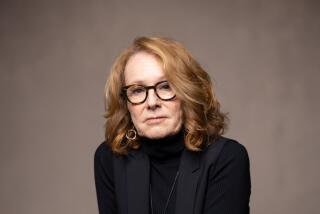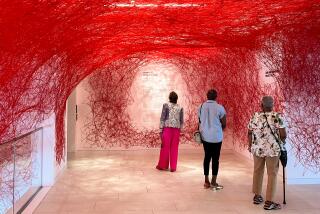Hammer Museum retools its ‘Made in L.A.’ biennial in the face of COVID-19
- Share via
The Hammer Museum’s fifth biennial, “Made in L.A. 2020: a version,” will be just that — a departure from what was initially planned for this year.
The exhibition — targeted for an unspecified date in September when the Hammer expects to reopen following its closure in mid-March — is being retooled in response to the COVID-19 crisis.
“Reality feels like a version of itself right now,” co-curator Lauren Mackler said. “So the version-ing extends to the exhibition. The title proved to be sort of prescient.”
“Made in L.A.,” this year spotlighting 30 emerging and underrepresented local artists, always has reflected the pressing issues of the day through painting, sculpture, photography, performance, textile, multimedia, assemblage and installation. Presenting live performance during a pandemic will be a particular challenge.
The free exhibition, which originally was set to open June 7 and which will for the first time also take place at the Huntington Library, Art Museum, and Botanical Gardens in San Marino, includes five performance works, most meant to take place multiple times. Curators Mackler and Myriam Ben Salah, along with assistant curator of performance Ikechukwu Onyewuenyi, had planned to bundle performances into three weekends — one each in June, July and August. Performances now will be spaced out so as not to draw large crowds. They also will be viewable virtually on both museums’ websites.
“The artists are really taking part in the conversations around documentation,” Ben Salah said. “We’re not just placing a camera in front of the performer and letting it roll but thinking about lighting, cinematography, angles and editing. It should live online as a proper object in and of itself.”
Two months prior to the exhibition opening, many of the artists are reworking their performances.
Aria Dean had planned to present a four-person play inside a two-way-mirrored cube, with performers wearing body cameras to capture their point of view. The artist was going to broadcast edited footage on screens above the cube. She has since reinvented the piece as a one-person, three-episode “television play,” recorded in advance without an audience — a quarantine-like environment that’s been enriched by the challenges, Mackler said.
Jacqueline Kiyomi Gordon’s performance was meant to take place in a two-room structure inside of which different materials — felt or PVC curtains, for example — manipulated the sound. Performers were to circulate through the rooms, mixing with the crowd while vocalizing AI-manipulated speech. Now the performance will feature just one person in a mask, with only four audience members at any given time. And the artist, for whom materials are a point of inquiry, is designing a custom mask for the performer.
Ligia Lewis is rechoreographing her “Deader Than Dead” dance to incorporate masks and social distancing. The work, Ben Salah said, “was already about dancers dying onstage, so it resonates with the current times.”
This year’s exhibition highlights conceptual throughlines in the artists’ work, including entertainment and the theater-film convention of the fourth wall, as well as concepts that seem prescient now, such as “virality and viruses and political horror,” Ben Salah said.
“Lots of artists were already dealing with the conditions we’re living in now,” she added. “But some of the works have evolved to acknowledge the new conditions in which they’ll be presented. We were lucky to be working with artists showing a level of resilience and flexibility.”
Justen LeRoy, who works under the name SON., is presenting a biweekly podcast dealing with Black male identity. Some of the content will come from a conversation series held in the back of a South L.A. barbershop. It was intended to be listened to as artgoers traveled between “Made in L.A.” venues. Now a percentage of the audience likely will be listening at home, and the content will be more fluid. Instead of recording about six hours of the podcast in advance and launching segments throughout the summer, the artist plans to record about half of the content as the summer goes on, in order to be responsive to current events.
Artist Kahlil Joseph, cofounder of L.A.’s Underground Museum, will present “BLKNWS,” a news feed spotlighting original video footage and a mix of found film clips, music videos, academic lectures and other images. It was supposed to be broadcast at locations where people congregate, where they would stumble on it unexpectedly, such as restaurants and hair salons. That’s still the plan, but with business closings and changes to where people congregate, locations are more limited.
With COVID cases spiking again, “It’s very touch-and-go,” Onyewuenyi said. “Kahlil wants to focus on places that have a community ethos, spaces connected to the Underground Museum and BLKNWS. It’s a matter of do they still have foot traffic? And that’s changing day by day.”
Immersive works also presented challenges.
A re-creation of the late French-Moroccan artist Nicola L’s 1969 sculptural installation, “La Chambre en fourrure” (“The Fur Room”), is a freestanding structure covered with purple fur. It features pockets into which viewers can slide their faces and arms, “wearing” the work as if it were a costume. That’s no longer possible. The curators are working with the artist’s estate to “neutralize the piece, make it inactive,” Mackler said. “It’s not what was intended, but it makes it more poignant because it highlights the limitations of this moment.”
Writer-curator Sabrina Tarasoff built an immersive haunted-house installation with a narrow maze to be shown at the Huntington. The work — a nod to the Venice literary arts center Beyond Baroque and its ’70s and ’80s poetry scene — hasn’t changed physically but now will accommodate only one visitor at a time.
Both the Hammer and the Huntington are implementing safety precautions similar to other museums around the U.S., including timed ticketing with online reservations, reduced capacity to improve social distancing, floor markers to reduce cross-traffic, hand sanitizer stations and the mandatory wearing of masks. The Huntington — which reopened outdoor areas to the public on July 1 and will reopen indoor galleries incrementally starting in September — instituted one-way garden pathways to avoid congestion.
But whether the biennial — and the Hammer — actually opens in September is still a question mark. The date may seem overly optimistic to those fearing a second wave of coronavirus infections this fall.
“We’re not ready to talk about a second wave when the first isn’t over,” museum spokesperson Nancy Lee said. “We’re just being super cautious. If we have to push back an opening, we would. Safety is a priority.”
More to Read
The biggest entertainment stories
Get our big stories about Hollywood, film, television, music, arts, culture and more right in your inbox as soon as they publish.
You may occasionally receive promotional content from the Los Angeles Times.










